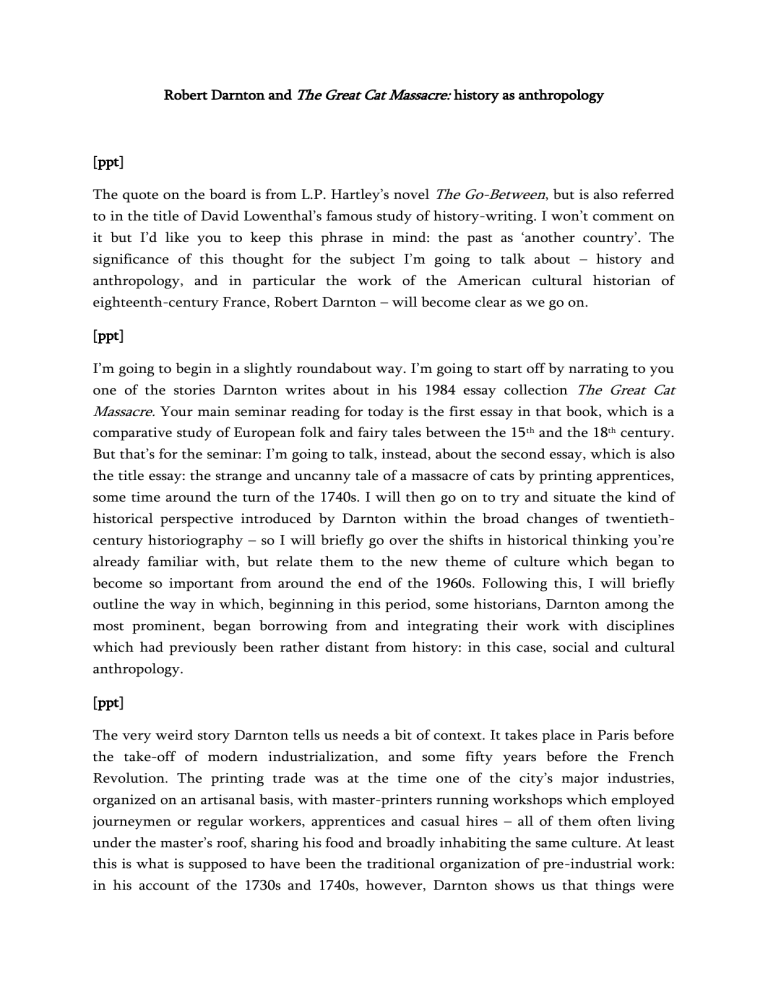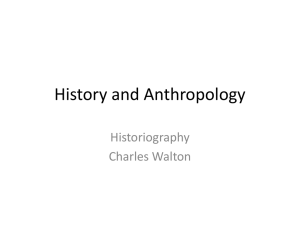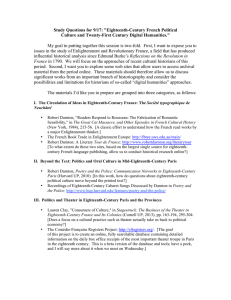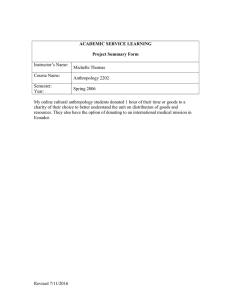Robert Darnton & The Great Cat Massacre: History as Anthropology
advertisement

Robert Darnton and The Great Cat Massacre: history as anthropology [ppt] The quote on the board is from L.P. Hartley’s novel The Go-Between, but is also referred to in the title of David Lowenthal’s famous study of history-writing. I won’t comment on it but I’d like you to keep this phrase in mind: the past as ‘another country’. The significance of this thought for the subject I’m going to talk about – history and anthropology, and in particular the work of the American cultural historian of eighteenth-century France, Robert Darnton – will become clear as we go on. [ppt] I’m going to begin in a slightly roundabout way. I’m going to start off by narrating to you one of the stories Darnton writes about in his 1984 essay collection The Great Cat Massacre. Your main seminar reading for today is the first essay in that book, which is a comparative study of European folk and fairy tales between the 15th and the 18th century. But that’s for the seminar: I’m going to talk, instead, about the second essay, which is also the title essay: the strange and uncanny tale of a massacre of cats by printing apprentices, some time around the turn of the 1740s. I will then go on to try and situate the kind of historical perspective introduced by Darnton within the broad changes of twentiethcentury historiography – so I will briefly go over the shifts in historical thinking you’re already familiar with, but relate them to the new theme of culture which began to become so important from around the end of the 1960s. Following this, I will briefly outline the way in which, beginning in this period, some historians, Darnton among the most prominent, began borrowing from and integrating their work with disciplines which had previously been rather distant from history: in this case, social and cultural anthropology. [ppt] The very weird story Darnton tells us needs a bit of context. It takes place in Paris before the take-off of modern industrialization, and some fifty years before the French Revolution. The printing trade was at the time one of the city’s major industries, organized on an artisanal basis, with master-printers running workshops which employed journeymen or regular workers, apprentices and casual hires – all of them often living under the master’s roof, sharing his food and broadly inhabiting the same culture. At least this is what is supposed to have been the traditional organization of pre-industrial work: in his account of the 1730s and 1740s, however, Darnton shows us that things were actually changing quite rapidly. Printing was becoming a bigger business, with bigger employers driving small workshops out of business. The master printers were becoming more like classical capitalist employers. Unlike earlier, they often no longer worked in the workshops themselves, but acted more purely as owners of businesses. This also involved aspiring to full-fledged ‘bourgeois’ status, and acquiring new tastes: one of the peculiar new practices adopted by printers, which we’ll see the consequences of shortly, was keeping cats, sometimes in very large numbers, as pets. Working conditions were at the same time becoming rather worse for workers and apprentices in the workshop: they worked longer hours, and often experienced more hostile relations with their masters. This very broadly is the immediate context in which Darnton’s story is situated. One of the apprentices in a Paris print-shop, a man named Nicholas Contat, wrote an account of his days as an apprentice, which was published in 1762. Print-workers, who worked with words, were among the few sections of Parisian workers who could – and frequently did – leave written accounts behind. Contat, in this memoir, where he used the pseudonym ‘Jerome’, wrote some pages about an incident which took place at his master’s print-shop twenty-odd years ago. This was a clearly a painful and harsh time for workers at this particular workshop. Apprentices laboured from early morning, around 4, till well into the evening. Their master only occasionally came into the workshop, mainly to yell at them. They were not allowed to eat at their master’s table, but were fed scraps of food from his leftovers. They often didn’t even get these: the cook, instead, gave them rotten cat food, rancid meat which cats themselves wouldn’t eat. The cat theme continues in all sorts of ways. The two apprentice workers, Jerome (or Contat) and Leveille, were often unable to sleep at night because of the howling and fighting of neighbourhood alley cats. Further: their master’s wife owned a cat, nicknamed la grise (‘the grey’), which was much-valued in the household. So one day the two apprentices decided to turn the tables, in the form of an exceptionally cruel practical joke. One of them spent all night outside the master’s window imitating a cat: he was apparently an exceptionally skilled mimic. This kept the master and his wife up all night: they then instructed the apprentices to get rid of the alley cats, but to make sure that they left the wife’s cat alone. Jerome and Leveille, of course, had planned just the opposite. Beginning with the household favourite, la grise, whose spine they smashed with a crowbar, they began rounding up, killing and torturing all the neighbourhood cats, away from their boss’s gaze. They trapped cats in sackcloths, tortured them, and then held a mock trial and sentenced them to death by hanging – a sentence which they then carried out. The master’s wife caught wind of what was going on, and was horrified to see what she rightly thought was her own cat’s body hanging from a noose in the yard – but the workers denied they could have done such a thing, and protested in loud terms that they had too much respect for their employment for that. For days afterwards, it seems, the two apprentices dined out on the story of their massacre of cats, and how they’d turned the tables on their master. Leveille, the worker whose brain-child the enterprise had been, apparently imitated the whole proceedings for his fellow-workers on multiple occasions. This produced great laughter and hilarity: the joke was shared by all the workers with tremendous enthusiasm. Now it might be very useful and interesting to speculate about what the historians you’ve read so far in the course might have had to say about an event of this sort. How would Ginzburg, Thompson, or Lucien Febvre have dealt with it? I’m not going to discuss this here, it would be a digression – but it’s worth thinking about in your seminars perhaps. It is perhaps possible to make a couple of broad points. First, for most ‘traditional’ histories this would not have been an event worth considering except as some sort of stray illustration of popular unrest. For various post-war social history traditions, Marxist and non-Marxist, we can maybe imagine various sorts of treatments of this episode. We can imagine it being handled in terms of popular protest, as a precursor to the class conflicts of the French Revolution, as an insight into class relations during the Old Regime in France. In most forms of social history, however, what would be of interest in the great cat massacre is the sequence of events themselves – what happened, who made it happen, why it happened, and what the consequences were. Further, it’s not hard to imagine the massacre of cats being part of a broader narrative of French social history, perhaps in the mode of ‘history from below’, but nonetheless to be principally studied in terms of how it fits into an overall narrative of social and political transformation. Beyond this, it is also possible to picture a post-structuralist rendering of this event: this would involve very careful, literary-critical attention to the text by Contat the apprentice printer, which is our source for this event. Rather than an account of events, a post-structuralist analysis would give us a deconstruction of the text, the source, an analysis of its internal tensions and ambiguities. So, in theory, an event of this sort certainly can be handled as a piece of either social history or textual analysis. But Darnton offers another way of dealing with it. In a nutshell: Darnton does not seek to understand the cat massacre in terms of its underlying causes and what it led to. He is not principally concerned with the events in themselves, and is disinterested in their consequences. Instead, he focuses on the element in the events which, to our sensibilities, is bound to be the most unsettling and puzzling bit: the laughter of the men. What was so funny about this brutal and cruel episode of random slaughter? Darnton argues that precisely because this element is most opaque to us, most distant from the way we organize the world in our heads, it must be placed at the centre of analysis. Here is how he puts it: [ppt] Our own inability to get the joke is an indication of the distance which separates us from the workers of preindustrial Europe. The perception of that distance may serve as the starting point of an investigation, for anthropologists have found that the best points of entry in an attempt to penetrate an alien culture can be those where it seems to be most opaque. When you realize that you are not getting something – a joke, a proverb, a ceremony – that is particularly meaningful to the natives, you can see where to grasp a foreign system of meaning in order to unravel it. By getting the joke of the great cat massacre, it may be possible to “get” a basic ingredient of artisanal culture under the Old Regime. So the element of surprise is crucial to Darnton’s historical methodology. Indeed, the entire book is full of reiterations of this principle. At the very beginning, in the preface, Darnton writes pretty much the same thing: “When we cannot get a joke, or a ritual, or a poem, we know we are on to something. By picking at the document where it is most opaque, we may be able to unravel an alien system of meaning.” And a page before this, he has already written: [ppt] …other people are other. They do not think the way we do. And if we want to understand their way of thinking, we should set out with the idea of capturing otherness. […] nothing is easier than to slip into the comfortable assumption that Europeans thought and felt two centuries ago just as we do today – allowing for the wigs and wooden shoes. We constantly need to be shaken out of a false sense of familiarity with the past, to be administered doses of culture shock. I’m not going to outline Darnton’s own thoughts about how this particular episode, the cat massacre, should be interpreted, and what it teaches us. For that you have to read the essay itself. But we’re concerned here with questions of methodology, and Darnton sums up his methodology in very clear terms here. The emphasis is constantly on an insurmountable, radical difference which separates the researcher of social life and the subjects he or she is researching. What is important is that for Darnton this apparent obstacle is actually the very thing which makes substantial interpretation possible. To truly understand the past, for him, is to understand what truly makes it different from the time we live in and are familiar with. The theme runs through the essays in Darnton’s book. To take just one example, in the text you have for today’s seminar, he begins with the same technique of defamiliarization. He takes something which on the surface should be familiar enough to us – the story of Red Riding Hood – and then shows us how it actually contains the deposits of a mental universe completely of its own time, and not of ours – of a world different from ours in every sense. He consults existing interpretations – mainly psychoanalytic – of fairy tales, and finds them defective because the elements they analyse didn’t exist at the time these stories were conceived and composed. This very historical distance from our familiar landmarks, far from being a disadvantage, is both the condition of research and its chief objective. In other words, rather than trying to make the cat massacre or French folktales available to us, in terms that we would use, Darnton wants to acquaint us with the terms they use, which are nothing more or less than the terms on which the past existed. In order to make further sense of this, it might be useful to take a brief glance backwards, at other forms of historiography which you’re now familiar with, and compare them with Darnton’s method. If we do this it becomes possible to see both how Darnton is part of the broad direction, or trajectory, of changes in historical thinking in the twentieth century, as well as the way in which the approach he represents is different from those which preceded it. [ppt] For most forms of traditional history-writing till the early-to-mid twentieth century, an event like the great cat massacre would simply not have existed as a piece of usable historical evidence. Histories that focused on great men, political elites and big public events were not inclined to consider ‘minor’ incidents like this, with no measurable impact upon the course of history, as serious sources for historical analysis. The rapid rise of social history after the Second World War did of course make historians more sensitive to these sorts of sources. For Marxist social historians, for instance, accounts of such social turbulence could be fitted into an evolving pattern of forms of class politics. The Annales historians, from the 1970s, went a step further, and introduced the studies of mentalities. This involved a study of what would come to be called ‘the collective mind’ – the overall belief systems and attitudes of a culture or civilization or nation. If you recall that the 1950s to the 1970s represented the great age of quantitative history, however, you can see the difference between that and the orientation towards cultural history which I have tried to show in Darnton’s work. For French historians between the 50s and the 70s, counting became a preferred mode for figuring out popular attitudes and dispositions. Historians like Pierre Chaunu, Michel Vovelle, Daniel Roche and Roger Chartier, counted masses for the dead, printed titles of books, crimes in police records, invocations of the Virgin Mary in wills, in order to arrive at an understanding of people’s changing orientations towards the world, their religious beliefs and attitudes, and so on. Overall, there continued to be a commitment, in both Marxist and Annales traditions, to tend to derive cultural facts from social structures, demography and economics. Darnton and the ‘new cultural history’, which emerged in the 1970s and 1980s, would question this, pointing out that culture could not be treated as a derivative, since it dealt with the realm of human meanings. If we turn to the various forms of history from below from the 1960s onwards, beginning with the work of Thompson, we can see a radically altered attitude to popular culture, belief, rituals, etc. Thompson, especially in work published after The Making of the English Working Class, turned to the study of popular customs in the eighteenth century, often drawing heavily upon anthropological perspectives – I’ll come to the significance of this in a moment. As various scholars have pointed out, Thompson’s work was crucial: with his practice of history from below, he opened up the path for a new kind of cultural history, which ironically ended up displacing the concept of class from the centre-stage of historical research, much against Thompson’s own strictures. He still, however, tended to situate these cultural forms within a long-term perspective of historical transformation: the point was both to describe what plebeian and peasant communities made of their own worlds, and how this was a part of processes of historical change. With micro-history and the work of Ginzburg and Natalie Zemon Davis, we find an even further expanded attention to questions of culture and belief. Ginzburg of course tried to outline the mental world of an obscure miller in 16th century Italy, and Zemon Davis, in her classic 1973 work, Rites of Violence, interpreted the 16th century European wars of religion in terms of the way people expressed their beliefs. But if we look at Ginzburg’s text, for instance, a little closely, we do find a gap between the sort of micro-history he practised, and that practised by Darnton. Recall that Ginzburg writes, with sadness, of the fact that Menocchio’s world is in large degree lost to us: he describes this, in moving and striking tones, as ‘a historical mutilation of which we are, in a sense, the victims’. Compare this with Darnton’s emphasis on the fact that it is actually our very distance from this world which opens up the possibility for studying the history of an unfamiliar people. The post-modernist or textual turn in history-writing embodies another way in which historians began taking matters of culture and belief seriously in their work. One can easily imagine a post-structuralist reading of the printer’s memoir which Darnton uses in his essay on the cat massacre, or of the folktales which he uses in his ‘Peasants Tell Tales’. But here too there is also a difference: a post-structuralist would, above all, be focused on the text itself, on the tensions and ambiguities within Contat the printer’s representation of the great cat massacre. As Dominick La Capra points out in a very critical review, Darnton does not really do this – he simply acknowledges that he is using a textual representation, and then moves on without considering it as a text or attending to its literary construction. The point that emerges from all this is that by the 1970s and 1980s, a more favourable climate certainly existed for the sort of study Darnton was engaged in, but he was at the same time part of a new break in historical research, associated with a form of cultural history without a clear precedent. Let me try to explain this in some detail, by turning to perhaps the most important element in the historical methodology used by Darnton – its associations with anthropology. Consider again the way in which Darnton poses the problem for the historian – whether it comes to French folktales or the cat massacre. I earlier said he focuses on the absolute difference between the past and us: it is now time to put this in more precise terms. Let’s go back to those quotes I showed you earlier: notice that he speaks of the need to ‘grasp a foreign system of meaning in order to unravel it’. When it comes to past historical actors – like the apprentices in the print-shop – he talks of needing to ‘understand their way of thinking’. And he speaks of this as ‘culture shock’: quite literally, in discovering the past, we are discovering an unfamiliar culture. This might seem transparent enough: we can vaguely talk of ‘understanding’ people in the past ‘on their own terms’, and so on. But Darnton is after something a great deal more precise here. He wants to investigate the meanings which people in the past assigned to what they did, and from that he wants to figure out the specificities of the culture they inhabited. And here we come to the key intellectual influence upon Darnton: social and cultural anthropology. At the very beginning of his book, he talks of the influence of anthropology upon his own historical practice, and constructs the object of his own research in line with anthropological insights. And he spells this out very clearly when he defines what he’s setting out to do [ppt]: “it might simply be called cultural history; for it treats our own civilization in the same way that anthropologists study alien cultures. It is history in the ethnographic grain.” So what was so compelling about anthropology at the time Darnton wrote? [ppt} Why did he seek to align the craft of the historian with that of the ethnographer? Prior to the late 1960s, anthropology and history had not really intermeshed very much. As you already know, the major interdisciplinary exchanges that historians participated in took place with economics, statistics, demography and sociology. The vast influence of quantitative history till the 1960s made such an encounter between history and anthropology even less likely. The Annales historians in particular often used quantification as a way of getting at really large time-frames; in the case of Braudel, time-frames which ruled out human agency. Anthropology, by contrast, focused on extremely minute data: anthropologists set their studies among groups insulated from modern life, such as Amazon tribes or Pacific islanders (there was an excessive and disturbing focus on what were considered ‘primitive’ cultures); alternatively, they located their research in small villages. So anthropology, in its subjects of research and in its methodology, seemed very remote for history with its search for big patterns and changes. Anthropologists concentrated on the particular; historians, till the 1960s, on the general. Anthropology itself had been going through some major changes in the postwar period, much like history itself. In the 1950s and 1960s, structural anthropology, especially in the work of Claude Levi-Strauss, became extremely influential: along with linguistics and psychoanalysis, anthropology became one of the big sources of the structuralist movement. You have already studied some of this when you studied postmodernism and post-structuralism. Levi-Strauss applied a structuralist model, partly inherited from linguistics, to look for the binary oppositions of values and meanings which shaped people’s lives in ‘primitive’ societies, and on that basis formulated a general theory of social life, in terms of deep underlying structures beneath human behaviour, thought and action. Patterns of kinship, and structures of myth and ritual became key to deciphering what communities very distant from Western civilization were all about. The most influential figure in anthropology from the 1970s onwards, however, was an American scholar who radically transformed the discipline, and became known as the foremost figure in the field of cultural anthropology. This was Clifford Geertz, whose writings dealt with rituals, customs, religious life, and politics in Java, Bali, Sumatra and Morocco. Interestingly, he combined these with studies of political changes in new postcolonial states in the 1950s and 1960s: India, Indonesia, Malaya, Burma and so on. This distinguished him from the main traditions of anthropology, where there remained an exotic residue of ‘studying the native’ in societies untouched by Western civilization, in a sense frozen from history. Geertz focused on local customs and rituals, but also situated them within a wider historical narrative, thus making anthropological approaches more accessible to historians. Geertz’s most famous work, The Interpretation of Cultures, was published in 1973, and had a signal influence both within anthropology and in other disciplines, including history. Geertz became particularly influential for his adaptation and use of the notion of ‘thick description’, as developed by the British philosopher Gilbert Ryle. This was, at the most basic level, a new sort of attention to context. In order to understand the difference between ‘thin’ and ‘thick’ description, it is perhaps best to use the example which Ryle himself gave. Consider two apparently similar cases. In one, my eye twitches involuntarily. In the other, somebody winks at somebody. Now from an external viewpoint, the two gestures are identical: the twitch and the wink are the same. But their meanings differ radically: one is a reflex action, the other is a deliberate, conspiratorial gesture made by one person towards another. We can multiply this: consider a third case, where somebody decides to parody somebody else’s eyelid contracting in a twitch. Here, once again, to a superficial glance all you have is someone twitching their eyelid. But in reality, this is a wink which parodies a twitch. All this seems very whimsical, I know. But Ryle was using this example to make a point about differences between different ways in which we can describe the same event or situation. For a ‘thin’ description of this situation, all you have is three people twitching their eyelids. But a thick description would take account of all the meanings loaded into these apparently similar gestures – therefore, while a ‘thin’ description merely observes ‘neutrally’, a thick description deciphers meanings. Geertz insisted that this was what anthropologists, and by extension all observers of social reality, were doing, whether they knew it or not. In his words, ‘what we call our data are really our own constructions of other people’s constructions of what they and their compatriots are up to.’ This is in a sense the zero-level of analysis: it is the point that all analysis of human behaviour has got to start from. But where do these meanings come from? This, for Geertz, was where the concept of culture was all-important. And culture, for Geertz, meant above all a set of shared meanings. [ppt] It is necessary to note that this actually marked a very major break in the theory of culture. For most anthropological approaches before Geertz, culture had been located within the human mind. Geertz however was emphatic that this was not the case. Based on his use of ‘thick description’ as an appropriate technique for the anthropologist, Geertz made the crucial point that culture is a public thing. “Culture, this acted document, thus is public...Though ideational, it does not exist in someone’s head; though unphysical, it is not an occult entity.” [ppt] The point was that culture was the realm of human activity as such – of that dimension of human activity which produced meanings. Human action has a symbolic dimension: through the study of gestures, manners, customs, rituals and daily practices, we can arrive at an understanding of people’s understandings of themselves. So all of this helps us understand what was new about the kind of history Darnton and others began writing in the 1970s and 1980s. In addition to the linguistic turn, history now took a decidedly ‘cultural’ turn – informed in differing degrees both by literary and by anthropological perspectives. The rise of oral history after the 1960s can also be seen as an instance of this: historians began supplementing or even replacing their archival world with field research, based on interviews and conversations. Studies of subjects like popular memory and representations of the past flourished. And undergirding all this was a new attention to culture, conceived very much as the production of systems of meaning shared by large numbers of people. If the 1960s and 1970s had been the great age of historical studies of class, by the 1980s this had come in large measure to be displaced by an attention to culture. Anthropology, psychology, anecdotes, myth, custom and ritual all became new points of entry into the field of cultural history. Let me end with a slightly speculative point about the new cultural history introduced by figures like Darnton. Till the rise of interest in matters of culture and ethnographic approaches to history, historians had mainly tried to track processes of change across time. This could of course take various forms: for instance, one form for Eric Hobsbawm, and a totally different one for EP Thompson. Yet ever since the rise of social history under the twin influence of Marxism and the Annales school, and arguably even in older traditional forms of history-writing, the idea of history as process, with questions of continuity and change at its forefront, had remained central. Historians, especially after the birth of history from below, could engage in detailed studies of social and cultural contexts, but these studies were generally plotted as part of arguments about long-term trends and processes. For Darnton, if you look at the texts in The Great Cat Massacre closely, you find that the order is now reversed. He does not use an incident like the cat massacre in order to illuminate an ongoing historical process. This does not mean that he is inattentive to the changes it is part of: on the contrary, he writes about them succinctly. However, now it is the long-term changes which supply a sort of broad context. The cat massacre, however, is in itself and by itself the object of study. The point of studying it is not to track a process of change, but to enter into the depths of cultural meaning in a society which is frozen for the purposes of research. If I could use a somewhat fanciful cinematic metaphor, this is not history as a series of tracking shots, but as series of freeze-frames. Moments in the past could crystallize as objects of research in themselves, and the historian could now, unlike before, afford to be less interested in the change/continuity question. A riot, a book, a festival, an encounter: these sorts of moments, under the influence of cultural history, were no longer simply ‘part’ of historical processes. In the hands of historians like Darnton, they became the very object of research. And here, once again, we find the centrality of the anthropological turn.

![The Great Cat Massacre: history as anthropology Robert Darnton and [ppt]](http://s2.studylib.net/store/data/013091026_1-75ffe15d16b09f4c083e7b861fc29d81-300x300.png)





